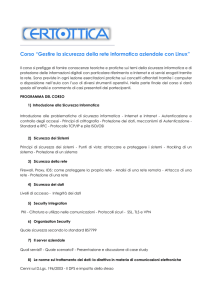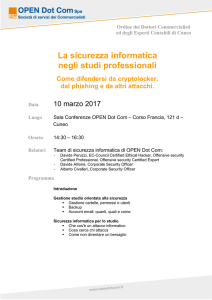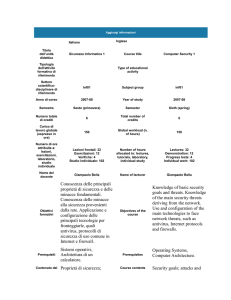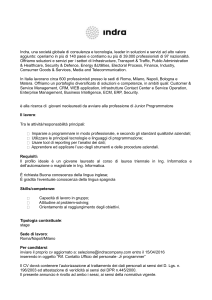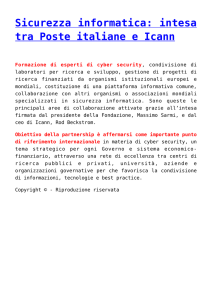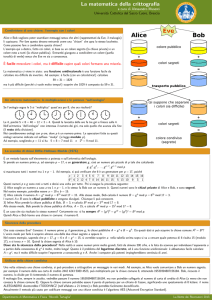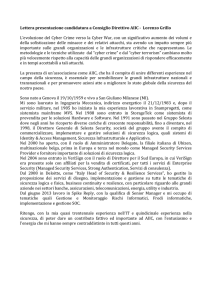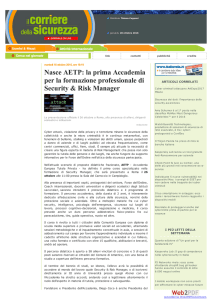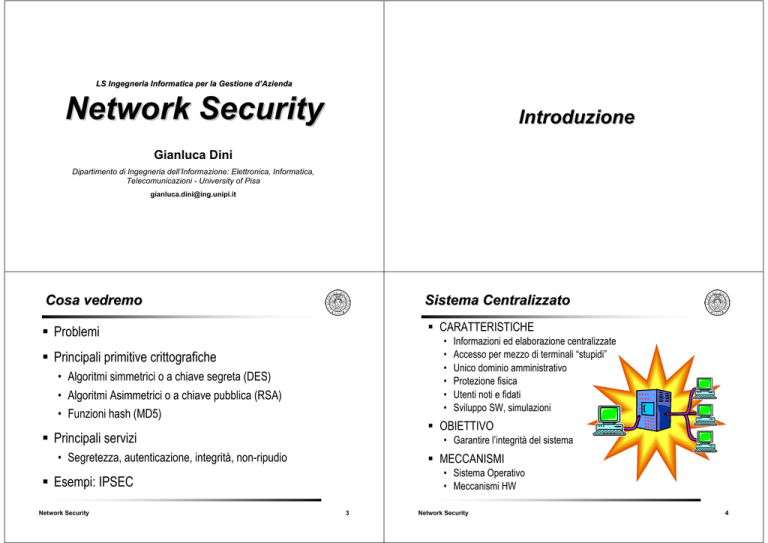
LS Ingegneria Informatica per la Gestione d’
d’Azienda
Network Security
Introduzione
Gianluca Dini
Dipartimento di Ingegneria dell’Informazione: Elettronica, Informatica,
Telecomunicazioni - University of Pisa
[email protected]
Cosa vedremo
Sistema Centralizzato
CARATTERISTICHE
Problemi
•
•
•
•
•
•
Principali primitive crittografiche
• Algoritmi simmetrici o a chiave segreta (DES)
• Algoritmi Asimmetrici o a chiave pubblica (RSA)
• Funzioni hash (MD5)
OBIETTIVO
Principali servizi
• Garantire l’integrità del sistema
• Segretezza, autenticazione, integrità, non-ripudio
MECCANISMI
• Sistema Operativo
• Meccanismi HW
Esempi: IPSEC
Network Security
Informazioni ed elaborazione centralizzate
Accesso per mezzo di terminali “stupidi”
Unico dominio amministrativo
Protezione fisica
Utenti noti e fidati
Sviluppo SW, simulazioni
3
Network Security
4
Local Area Network
Wide Area Network
CARATTERISTICHE
CARATTERISTICHE
•
•
•
•
•
Condivisione di risorse (file, stampanti, CPU)
Workstation (Windows, Unix, MS-DOS)
Unico dominio amministrativo
La rete è sicura
Sviluppo SW, simulazioni
•
•
•
•
OBIETTIVO
OBIETTIVO
• Garantire l’integrità del sistema
• Confidenzialità, Autenticazione,
Integrità, Non-ripudio
MECCANISMI
• Autenticazione basata sull’indirizzo
(address-based authentication)
Network Security
Domini applicativi differenti
Utenti sconosciuti o inaffidabili
La rete è insicura
Applicazioni: e-Commerce,
telemedicina,…
MECCANISMI
• Cifratura, Firma digitale, Funzioni hash
5
Attacchi alla sicurezza
Network Security
6
Rilascio del contenuto dei messaggi
messaggio in chiaro
Rilascio del contenuto dei messaggi
Analisi del traffico
Impersonificazione (masquerade)
Bob
Modifica dei messaggi
Vediamoci alle 20:00!
Alice
Cancellazione dei messaggi
L’avversario ricava il contenuto delle trasmissioni
Replicazione dei messaggi (replay)
Network Security
Avversario Passivo
(eavesdropper; sniffer)
7
Network Security
8
Analisi del traffico
Impersonificazione (masquerade)
messaggio cifrato
Sono Alice, trasferisci1000€ dal mio
conto a quello di Mr. Lou Cipher
Avversario passivo
Avversario attivo
xhhjo12&v d2}} hfo0
L’avversario determina l’identità degli host comunicanti, la
frequenza e la dimensione dei messaggi
Network Security
L’avversario finge di essere un entità (host, user) diversa.
9
Modifica dei messaggi
Pagate 100€ a
Mr. Lou Cipher
Network Security
10
Cancellazione dei messaggi
Pagate 1000€ a
Mr. Lou Cipher
Avversario attivo
L’avversario modifica porzioni di un messaggio
Network Security
Avversario attivo
11
Network Security
12
Replicazione dei messaggi (replay)
ATTACCHI ALLA SICUREZZA
Tipo
PASSIVO
Pagate 100€ a
Mr. Lou Cipher
Attacco
Rilascio messaggi
Analisi del flusso
Contromisure
Difficili da rilevare; facili
da controbattere
Masquerade
Avversario attivo
Modifica messaggi
ATTIVO
L’avversario intercetta un messaggio e lo ritrasmette
una o più volte
Network Security
Replay
Facili da rilevare; difficili
da controbattere
Negazione del
servizio
13
Servizi di sicurezza
Network Security
14
Crittografia
La crittografia è la disciplina che studia le tecniche
matematiche relative alla sicurezza (confidenzialità, integrità
dei dati, autenticazione e non-ripudio)
Confidenzialità (privacy, secrecy)
Integrità dei dati
Autenticazione
Identificazione
Provenienza dei messaggi
Le primitive crittografiche sono:
cifrari
Non-ripudio
funzioni hash
firma digitale
Network Security
15
Network Security
16
Regole fondamentali
Inventare un algoritmo crittografico è compito dei matematici,
ma utilizzarlo correttamente è compito di un ingegnere
informatico
Symmetric Encryption
Crittografia non è sinonimo di sicurezza
“Whenever anyone says that a problem is easily solved by
cryptography, it shows that he doesn’t understand it”
(Roger Needham/Butler Lampson)
Network Security
17
Symmetric Encryption Scheme
Security of a symmetric cipher (intuition)
M: message space
Let c = Ee(m) and m = De(c)
C: ciphertext space
The symmetric cipher (E, D) is secure iff
K: keyspace
Given c is difficult to determine m without knowing e,
and viceversa
E : P × K → C encryption transformation
D : C × K → P decryption transformation
Given c and m is difficult to determine e, unless it is
used just once
Two properties
∀m ∈ M, ∀e ∈ K, ∃d ∈ K: m = Dd (Ee (m ))
It is computationally “easy” to compute d knowing
e, and viceversa
In most practical symmetric encryption scheme e = d
Network Security
19
Network Security
20
2-party comm with symmetric encryption
Discussion
Bob
Alice
key source
e
c
Ee(m)
How can Bob be sure that m = De(c) is good?
secure(*) channel
unsecure channel
adversary
m
f Bob knows m in advance
Dd(c)
f Bob knows a part of m in advance (e.g., email)
f Bob knows that m has certain structural redundancies
(e.g., ASCII)
m
• Alice and Bob know E and D
• Alice and Bob trust each other
• key e is a shared secret between Alice
and Bob
(*)
the channel is not physically accessible to the adversary and ensures both confidentiality
and integrity
Network Security
21
Discussion
What is the effect of a “small” change in the
ciphertext?
Bob receives
Single bit change
f3 9e 8a 73 fc 76 2d 0f
59 43 bd 85 c3 c9 89 d2
bf 96 b6 4f 34 b8 51 dd
f c[0]7 = ~c[0]7 (73 9e 8a 73 fc ...)
f m′=“e8¢biö=}o alle 20:00!”
Bob deciphers c with
k = 0x3dd04b6d14a437a9
Single byte change
f c[c.lenght() − 1] = 0x00 (... 34 b8 51 00)
Bob obtains
m = “Ci vediamo alle 20!”
Network Security
22
Discussion
EXAMPLE (DES-CBC)
c=
Network Security
f m′=“Ci vediamo alle "}2gÀlõ”
23
Network Security
24
Discussion
On trust
What does “Alice and Bob trust each other” mean?
Alice (Bob) believes that Bob (Alice) does not reveal m
Upon seeing m, Bob believes that:
Alice (Bob) believes that Bob (Alice) keeps key e secret, i.e.,
f only Alice saw message m (privacy)
fAlice (Bob) believes that Bob (Alice) is competent to do
key management
f message m comes from Alice (?provenience?)
f message m has not been modified (?integrity?)
fAlice (Bob) believes that Bob (Alice) does not reveal the
key
Network Security
25
Esiste un cifrario perfetto?
26
One-time Pad (Vernam, 1917)
Con un cifrario perfetto, il crittoanalista, esaminando un
crittogramma c non acquisisce sul messaggio m alcuna
conoscenza di cui non disponesse già prima
Assumptions
Let m be a t-bit message
Let e be a sequence of t randomly chosen bits
• Shannon (1949) formalizzò questa proprietà in termini di processi
stocastici come segue.
Encryption and decryption functions
• Sia M una variabile aleatoria che assume valori nello spazio M dei messaggi
• Sia C una cariabile aleatoria che assume valori nello spazio C dei crittogrammi
Encryption: ci = mi ⊕ ei, 0≤ i ≤ t
• DEFINIZIONE. Un cifrario è perfetto se per ogni m∈M e per ogni c ∈ C, vale la
relazione P(M = m | C = c) = P(M = m)
Decryption: mi = ci ⊕ ei, 0≤ i ≤ t
TEOREMA. In un cifrario perfetto, il numero delle chiavi deve
essere maggiore o uguale al numero dei messaggi possibili
Network Security
Network Security
Esempio
• m = 01010101, e = 01001110, c = 00011011 (si noti che m è periodico ma c no)
27
Network Security
28
One-Time Pad è un cifrario perfetto
One-Time Pad
One-Time Pad is vulnerable to a known-plaintext attack
TEOREMA. One-Time Pad è un cifrario perfetto se la
chiave è scelta in modo perfettamente random per ogni
messaggio e
• key k can be easily obtained from m and c: ei = mi ⊕ ci
The key must be used only once.
Let us suppose that a key e is used twice, that is
c = m ⊕ e and c´= m´ ⊕ e.
It follows that c ⊕ c´ = m ⊕ m´.
This provides important information to a cryptanalyst who has both c
and c´. For instance, a sequence of zeros in c ⊕ c´ corresponds to
equal sequences in m and m´
1. tutti i messaggi hanno la stessa lunghezza t
2. tutte le sequenze di t bit sono messaggi possibili
One-Time Pad requires to generate a key of many random
bits: this problem is not trivial!
Network Security
29
Unconditional security
30
Security of one-time pad
Unconditional security (perfect secrecy)
One-time padding is unconditionally secure against
ciphertext-only attack
• An adversary is assumed to have unlimited computational
resources
• Any t-bit plaintext message m* can be recovered from a t-bit ciphertext
c by using a proper key e* = m* ⊕ c
• The uncertainty in the plaintext after observing the ciphertext
must be equal to the a priori uncertainty about the plaintext
The fact that the key should be at least as long as the plaintext
complicates key distribution and key management
• Observation of the ciphertext provides no information
whatsoever to an adversary
• A necessary condition for a symmetric-key encryption
scheme to be unconditionally secure is that the key bits are
chosen randomly and independently and the key is at least
as long as the message
Network Security
Network Security
• For this reason, in practice, stream ciphers are used where the key
stream is pseudo randomly generated from a smaller secret key
• These ciphers are not unconditionally secure but, hopefully, practically
secure
31
Network Security
32
One-time pad
An insecure systems made by secure components
c[i] = m[i] + e[i] mod 26
m = D A R E C E N T O E U R O A BO B
k = WCL N B T D E F J A Z G U I R X
c = Z CC R D X Q X T N U Q U U J F Y
m = “SUPPORT JAMES BOND”
m = S U P P O R T J AME S B O N D
k = W C L N B T D E F J A Z G U I R
c = OW A C P K W N F V ER H I V U
ZCCRD...
c' = Z C C R N B O P J N U Q U U J F Y
k = WCL N B T D E F J A Z G U I R X
m = D A R E M I L L E E U R O A BO B
c = OW A C P K W N F V ER H I V U
k' = M W L J V T S E F J A Z G U I R
m = C A P T U R E J AME S B O N D
Network Security
33
Block cipher
P
E
Network Security
C
C
D
For any key e, Ee defines a particular substitution (permutation)
P
N = 2n
e
random
|P| = |C| = n bits (block lenght)
e ∈ K ⊆ Vk
P ∈ P ⊆ Vn
C ∈ C ⊆ Vn
All the possible substitutions are 2n!
Therefore, in a true random cipher,
the key lenght
For any key e,
k = lg(2n!) ≈ (n − 1.44) 2n i.e., the key
lenght is 2n times the block lenght
• Ee(P) must be an invertible
mapping from Vn to Vn and
This key lenght is impractical
• De(P) is the inverse function
In practice, the encryption function corresponding to a randomly
chosen key should appear a randomly chosen invertible function
Vi set of i-bits vectors
Network Security
34
True random cipher
e
|e| = k bits (key lenght)
ZCCRN...
35
Network Security
36
Standard assumptions
Classification of attacks
Attacks are classified according to what information an
adversary has access to
The objective of the adversary is to recover the plaintext from
the ciphertext (partial break) or even the key (total break)
ciphertext-only attack
stronger
known-plaintext attack
chosen-plaintext attack
A cipher secure against chosen-plaintext attacks is also secure
against ciphertext-only and known-plaintext attack
It is customary to use ciphers resistant to a chosen-plaintext
attack even when mounting that attack is not practically
feasible
Standard assumptions. An adversary
1. has access to all data transmitted over the ciphertext
channel;
2. knows all details of the encryption function except the
secret key (Kerckhoff’s assumption)
Network Security
37
Computational (practical) security
Network Security
38
Attack complexity
Attack complexity is the dominant of:
A cipher is computationally (practically) secure if the
perceived level of computation required to defeat it, using the
best attack known, exceeds, by a comfortable margin, the
computation resources of the hypothesized adversary
f data complexity — expected number of input data
units required
f Ex.: exhaustive data analysis is O(2n)
f storage complexity — expected number of storage
units required
The adversary is assumed to have a limited computation
power
Network Security
f processing complexity — expected number of
operations required to processing input data and/or fill
storage with data
f Ex.: exhaustive key search is O(2k)
39
Network Security
40
Attack complexity
Exhaustive key search
Number of processors necessary to break a key
A block cipher is computationally secure if
Every processor performs 106 encryption/second
f n is sufficiently large to preclude exhaustive data analysis
f k is sufficiently large to preclude exhaustive key search
f no known attack has data complexity and processing
complexity significantly less than, respectively, 2n and 2k
Network Security
41
Exhaustive key search
1 Month
$24,000
1 Week
$6.2M
Network Security
$1.2×1026
830,000
64
590,000
7,100,000
3.1×107
2.1×108
128
1,1×1025
1,3×1026
5,6×1026
3,9×1027
1 Day
Network Security
42
Exhaustive key search has widespread applicability since
cipher operations (including decryption) are generally
designed to be computationally efficient
$100,000
$730,000
$27M
Given ( k + 4 ) n pairs of plaintext-ciphertext, a key can
be recovered by exhaustive key search in an expected time
O(2k-1)
$190M
128 bit
$9.4×1024
120,000
1 Week
Exhaustive key search may be a ciphertext-only attack if the
plaintext has known redundancy
1 Day
64 bit
$510,000
28,000
1 Month
Exhaustive key search is a known-plaintext attack
56 bit
$2000
2,300
1 Year
Exhaustive key search
Cost of a year-2005 hardware cracker
1 Year
Key size
(bit)
56
$4.9×1026
3.3×1027
Exhaustive DES key search requires 255 decryptions and one
plaintext-ciphertext pair
43
Network Security
44
Exhaustive data analysis
Cryptoanalysis: an historical example
Monoalphabetic substitution
A dictionary attack is a known-plaintext attack
Cleartext
ABCD E F G H I J K L M N O P Q R S T U V W X Y Z
alphabet
A dictionary attack requires to assemble plaintext-ciphertext
pairs for a fixed key
Key
J U L I S C A E R T V W X Y Z B D F G HK M N OP Q
The key is a permutation of the alphabet
A complete dictionary requires at most 2n pairs
Encryption algorithm: every cleartext character having position p in the
alphabet is substituted by the character having the same position p in the key
Decryption algorithm: every ciphertext character having position p in the
key is substituted by the character having the same position p in the cleartext
Number of keys = 26! – 1 ≈ 4 × 1026 (≥ number of seconds since universe
birth)
Network Security
45
Cryptoanalysis: an historical example
Network Security
46
Cryptoanalysis: an historical example
The monoalphabetic-substitution cipher maintains the
redundancy that is present in the cleartext
P = “TWO HOUSEHOLDS, BOTH ALIKE IN DIGNITY,
IN FAIR VERONA, WHERE WE LAY OUR SCENE”
It can be “easily” cryptoanalized with a ciphertext-only attack
based on language statistics
(“Romeo and Juliet”, Shakespeare)
P′ = “TWOHO USEHO LDSBO THALI KEIND IGNIT
YINFA IRVER ONAWH EREWE LAYOU RSCEN E”
Frequency of single
characters in English
text
C = “HNZEZ KGSEZ WIGUZ HEJWR VSRYI RAYRH
PRYCJ RFMSF ZYJNE SFSNS WJPZK FGLSY S”
Network Security
47
Network Security
48
Security of DES
data complexity
known
chosen
attack method
exhaustive
precomputation
exhaustive search
linear
cryptanalysis
Linear/differential cryptoanalysis
storage
complexity
2
56
1
1
—
negligible
255
243 (85%)
—
for texts
243
—
for texts
250
—
247
for texts
247
55
—
for texts
255
2
• è una tecnica di crittoanalisi per cifrari a blocchi ed a
caratteri
• Attribuita a Mitsuru Matsui (1992)
1*
—
238 (10%)
differential
cryptanalysis
Linear cryptonalysis
processing
complexity
Differential cryptoanalysis
• è una tecnica di crittoanalisi principalmente concepita per
cifrari a blocchi ma che può essere applicata anche ai cifrari
a caratteri
• Attribuita a to Eli Biham and Adi Shamir verso la fine degli
anni `80
* Table lookup
%: probability of success
Linear cryptanalysis is a known-plaintext attack
Differential cryptanalysis is primarily a chosen-plaintext attack
Network Security
49
Network Security
50
Cryptoanalysis of DES
Linear cryptonalysis
• A known-plaintext attack has O(243) data complexity and O(243)
computation complexity.
• With a chosen-plaintext attack, data complexity can be reduced by a
factor of 4.
Differential cryptoanalysis
• Known-plaintext attack has O(255) data complexity and O(255) computation
complexity
• Chosen-plaintext attack has O(247) data complexity and O(247)
computation complexity
• DES is "surprisingly" resilient to DC.
LC is the "best" analytical attack but is considered unpractical
Network Security
51
Encryption modes and
Multiple encryption
Electronic CodeBook
Cipher Block Chaining
3DES (EDE, EEE)
Encryption modes
Encryption modes: ECB
A block cipher encrypts plaintext in fixed-size
n-bit blocks
Electronic Codebook (ECB)
plaintext
When the plaintext exceeds n bit, there exist several methods
to use a block
∀1 ≤ i ≤ t , c i ← E k ( pi )
∀1 ≤ i ≤ t , pi ← Dk ( c i )
K
fElectronic codebook (ECB)
fCipher-block Chaining (CBC)
ciphertext
fCipher-feedback (CFB)
plaintext blocks are encrypted
separately
fOutput feedback (OFB)
Network Security
53
pi
E
ci
D
ci
pi
K
Network Security
Encryption modes: ECB
Encryption modes: ECB
Properties
AN EXAMPLE OF BLOCK REPLAY
54
A bank transaction transfers a client U’s amount of money D from
bank B1 to bank B2
Identical plaintext results in identical ciphertext
fECB doesn’t hide data patterns
• Bank B1 debits D to U
• Bank B1 sends the “credit D to U” message to bank B2
• Upon receiving the message, Bank B2 credits D to U
No chaining dependencies: blocks are enciphered
independently of other blocks
fECB allows block reordering and substitution
Format of a credit message
•
•
•
•
•
fError propagation: one or more bit errors in a single
ciphertext block affects decipherment of that block only
Src bank: M (12 byte)
Rcv banck: R (12 byte)
Client: C (48 byte)
Bank account: N (16 byte)
Amount of money: D (8 byte)
Cipher (n = 64 bit; modalità ECB)
Network Security
55
Network Security
56
Encryption modes: ECB
Encryption modes: ECB
block replay
AN EXAMPLE OF BLOCK REPLAY
Mr. Lou Cipher is a client of the banks and wants to make a fraud.
1.
Lou Cipher is an active adversary and wants to replay a Bank
B1’s message "credit 100$ to Lou Cipher" many times
Attack strategy
The adversary performs k equal transfers
• credit 100$ to Lou Cipher ⇒ c1
COMMENT. k is large enough
• credit 100$ to Lou Cipher ⇒ c2
to allow the adversary to identify
the cryptograms corresponding
• ...
to its transfers
• credit 100$ to Lou Cipher ⇒ ck
c1 = c2 = … = ck
• The adversary activates multiple transfers of 100$ so that multiple
messages "credit 100$ to Lou Cipher" are sent from B1 to B2
2.
3.
The adversary searches “his own” cryptograms over the network
The adversary replies one of these cryptograms
• The adversary identifies at least one of these messages
• The adversary replies the message several times
ci
Bank 1
Network Security
57
Encryption modes: ECB
T
2
M
3
4
5
6
R
58
CBC segue il principio di diffusione di Shannon introducendo una
dipendenza di posizione tra il blocco in elaborazione e quelli precedenti
An 8-byte timestamp field T is added to the message to prevent replay attacks
1
Network Security
Encryption modes: Cipher Block Chaining
AN EXAMPLE OF BLOCK REPLAY
block
no.
Bank 2
7
8
C
9
10
11
12
N
CBC è un cifrario a blocchi in cui blocchi identici del messaggio vengono
cifrati in modo diverso eliminando ogni periodicità
13
D
plaintext
However, the adversary can
1. identify “his own” cryptograms as before by inspecting blocks 2–13;
ci depends on pi and all
preceding plaintext blocks
2. intercept any “fresh” cryptogram;
3. substitute block 1 of “his own” cryptogram with block 1 of the “fresh”
cryptogram
ciphertext
Network Security
59
Network Security
60
CBC
CBC: properties
c 0 ← IV .∀1 ≤ i ≤ t , c i ← E k ( pi ⊕ c i −1 )
c 0 ← IV .∀1 ≤ i ≤ t , pi ← c i −1 ⊕ Dk ( c i )
IV
p1
p2
IV
IV can be sent in the clear; its integrity must be guaranteed
⊕
EK
c1
DK
⊕
p1
⊕
EK
c2
DK
⊕
p2
#
pn
Identical ciphertext result from the same plaintext under the same
key and IV
⊕
EK
Chaining dependencies: ci depends on pi and all preceding plaintext
blocks
f Ciphertext block reordering affects decryption
Error propagation: bit errors in ci affect decryption of ci and ci+1
#
cn
DK
Error recovery: CBC is self-synchronizing or ciphertext autokey
⊕
Framing errors: CBC does not tolerate “lost” bits
pn
Network Security
61
Multiple encryption
Network Security
62
Double encryption
If a cipher is subject to exhaustive key search, encipherment of a
message more than once may increase security
Multiple encryption may be extended to messages exceeding one
block by using standard modes of operation
m
Cascade cipher is the concatenation of L ≥ 2 ciphers, each with
independent keys
k2
E()
E()
c
Double encryption is subject to a known-plaintext attack called “meetin-the-middle” attack which requires 2k operations and 2k storage
units
Multiple encryption is similar to a cascade cipher but the ciphers are
identical (either E or D) and the keys need not be independent
Network Security
k1
63
Network Security
64
Triple encryption
EDE
m
Triple encryption
K
K´
K
E
D
E
EEE
c
m
K
K´
K''
E
E
E
c
Used in financial applications
ANSI X9.17 e ISO 8732
A known-plaintext attack similar to meet-in-the-middle, which requires 22k
operations and 2k units of storage
A chosen-plaintext attack which requires 2k operations, 2k data inputs and
2k storage units
A known-plaintext attack requires p data inputs,
O(p) storage units
2k+n/p
With DES, k = 56 (DES), the cipher is practically secure
operations, and
Backward compatibility: E when K = K'
Network Security
65
Network Security
66
Distribuzione delle chiavi
Alice e Bob devono condividere un segreto, la chiave K…
…ma come si fa a distribuire la chiave K ad Alice ed a Bob?
Key Distribution
La chiave K non può essere trasmessa in chiaro sulla rete
perché la rete è insicura
Network Security
68
Distribuzione delle chiavi
Point-to-point key management
point-to-point
Possibili soluzioni
• Faccia a faccia
• Corriere fidato
• Chiave in tanti pezzetti ed invio di ciascun pezzetto attraverso
un diverso canale di comunicazione (telefono, email,
piccione,…)
W
K
A
e.g., a client A has an account on server B
A and B a priori share a key W
Si vorrebbe utilizzare la rete per distribuire le chiavi
A and B wants to establish a session key K
69
Point-to-point key management
• tA is a timestamp (a “fresh” quantity)
requires synchronized clocks
with challenge-response
M1 A ← B : nB
M 2 A → B : EW ( nB , B, K )
• nB is a nonce (a “fresh” quantity)
Il protocollo 3WH richiede comunque un segreto
condiviso a priori (la chiave W)
• Offline
• Spesso W è ottenuta da una password P
Questa gestione delle chiavi non scala
A and KB are keying
A → B : EW ( K A , n B , n A , B ) • K
materiale
A ← B EW ( K B , n A , nB , A ) • K = f(KA, KB)
Network Security
70
Come si distribuisce questa chiave?
both parties contribute to the session key
M 1 A ← B : nB
• nA and nB are nonces
M2
M3
Network Security
Three Way Handshake
one-pass
M 1 A → B : EW ( t A , B, K )
B
Parties know each other
Non sempre queste soluzioni sono possibili e/o
economiche e/o efficienti
Network Security
W
• n utenti ⇒ n×(n-1)/2 chiavi di handshake ⇒
O(n2) segreti condivisi a priori
71
Network Security
72
Trusted Third Party
Kerberos
(Unix, W2K)
KAT
KBT
Trusted Third Party: il protocollo
I partecipanti non si conoscono ma si
fidano di una TTP
TTP mantiene segrete le chiavi
TTP sa costruire/distribuire le chiavi di
sessione
M1 A → T: A, B
M2 T → A: E(KAT, (t, L, KAB, B)),
E(KBT, (t, L, KAB, A))
KAT
KBT
M3 B → A: E(KAB,tA+1)
KAB?
• KAT: chiave utente segreta condivisa da Trent e Alice
• KBT: chiave utente segreta condivisa da Trent e Bob
• Obiettivo: Alice e Bob condividono la chiave di sessione KAB
Network Security
KAB?
73
Trusted Third Party: svantaggi (1)
t, tA: timestamp (nonce)
L: lifetime di KAB
Network Security
74
Trusted Third Party: svantaggi (2)
IN GENERALE:
IN GENERALE
• TTP può diventare un “collo di bottiglia”
Il protocollo TTP richiede segreti condivisi a priori
(KAT e KBT)
• prestazioni
• security
• Rispetto a 3WH, cambia la scala del problema
• TTP deve memorizzare chiavi a lungo termine
• TTP deve essere incondizionatamente sicuro
• n utenti ⇒ n chiavi utente condivise con TTP ⇒
O(n) segreti condivisi a priori
QUESTO PROTOCOLLO IN PARTICOLARE:
Il problema tuttavia resta
• Clock sincronizzati
Network Security
M3 A → B: E(KAB, (A, tA)),
E(KBT, (t, L, KAB, A))
75
Network Security
76
Protocollo Diffie-Hellman
Il problema del logaritmo discreto
Sia p un numero primo grande
Sia g, 1 ≤ g < p, un generatore di Zp*, ovvero tale che
∀ 1 ≤ n < p, ∃ un intero i per cui gi mod p = n
OBIETTIVO
Effettuare la distribuzione delle chiavi senza
bisogno di segreti condivisi a priori
ESPONENZIALE DISCRETO
Il protocollo DIFFIE-HELLMAN è un primo passo
verso la soluzione
Dati g, x, è facile calcolare y = gx mod p
LOGARITMO DISCRETO
Dati g, 1 ≤ y ≤ p-1, è difficile determinare x (0 ≤ y ≤ p-2) tale
che y = gx mod p
Network Security
77
Protocollo Diffie-Hellman: scenario
Network Security
Protocollo Diffie-Hellman: protocollo
b
a
78
b
a
KAB?
KAB?
Alice sceglie un numero random a
Bob sceglie un numero random b
•Sia p un numero primo grande,
M1 A → B: A, ga mod p
M2 B → A: B, gb mod p
•Sia 1≤ g < p
•I numeri p e g sono noti a tutti
Alice calcola
KAB = (gb)a mod p = gab mod p
Bob calcola
KAB = (ga)b mod p = gab mod p
Network Security
79
Network Security
80
Protocollo Diffie-Hellman: un esempio
Siano p = 11, g = 7
L’UOMO NEL MEZZO
Alice non ha nessuna garanzia che sta effettivamente
interagendo con Bob e viceversa
a
Alice pensa a = 3 e calcola ga
mod p = 73 mod 11 = 343 mod
11 = 2
b
KAB?
a
c
b
Bob pensa b = 6 e calcola gb mod p = 76
mod 11 = 117649 mod 11 = 4
MAN-IN-THE-MIDDLE ATTACK
A → B: 2
B → A: 4
L’uomo-nel-mezzo (l’avversario) può leggere e modificare tutti
i messaggi tra Alice e Bob senza che questi se ne accorgano
Alice e Bob si illudono di comunicare su di un canale sicuro
Alice riceve 4 e calcola KAB = (gb)a mod p = 43 mod 11 = 9
Bob riceve 2 e calcola KAB = (ga)b mod p = 26 mod 11 = 9
Network Security
81
L’UOMO NEL MEZZO
M → B : A, g mod p
c
b
KAM
M → A : B, g mod p
c
Bob calcola K BM
a
c
b
ac
( )
= (g )
K AM = g a
b
c
mod p = g ac mod p, e
c
mod p = g bc mod p
KAM, KBM
KBM
• Alice crede di comunicare con Bob per mezzo di KAM
bc
• Bob crede di comunicare con Alice per mezzo di KBM
Avversario calcola
K BM
Network Security
( ) mod p = g mod p
= ( g ) mod p = g mod p
Alice calcola K AM = g c
c
B → A [M ] : B, g b mod p
82
L’UOMO NEL MEZZO
a
A → B [M ] : A, g a mod p
Network Security
• L’avversario può
• leggere tutte le trasmissioni tra Alice e Bob
• impersonare ciascuno dei due
83
Network Security
84
Diffie-Hellman protocol
Alice,YA
Bob,YB
Carol ,YC
Diffie-Hellman protocol
Alice,YA
Public read-only file trusted
to preserve the integrity of
the pairs ⟨X, YX⟩
Bob,YB
#
Gimme Bob's Y
a
Here, it is! YB
Here, it is! #YB
b
b
Gimme Bob's Y
a
Network Security
85
Key distribution with public encryption
Here, it is! YC
Network Security
86
Key distribution with public keys
• A TTP certifies the public
key of each entity
Advantages
• No TTP is required
• The public file could reside with each entity
• Only n public keys need to be stored to allow secure
communications between any pair of entities, assuming
that the only attack is that by a passive adversary
Public file
certificate
Alice,YA , sA = ST ( Alice eA )
• ST and VT are the signing
and verification keys of the Bob,YB , sB = ST ( Bob eB )
TTP
Dave,YD , sD = ST ( Dave eD )
#
Disadvantages
• Key management becomes more difficult in the presence
of an active adversary
Network Security
Carol ,YC
The man-in-themiddle always
lies in wait
c
VT ( Alice eA , sA )
c = E eA ( m )
87
Network Security
88
Key distribution with certificates
Advantages
• It prevents and active adversary from impersonation on the network
• The TTP cannot monitor communications
• Entities need to trust the TTP only to bind identities to public keys
properly
• Certicates can be stored locally so eliminating per-communication
interaction with the public file
Asymmetric Encryption and
Digital signatures
Disadvantages
• if the signing key of TTP is compromised, all communications become
insecure
• All trust is placed with one entity
Network Security
89
CIFRATURA ASIMMETRICA
Chiave Pubblica e Privata
Algoritmo di Cifratura E()
•
Ogni utente ha una coppia di chiavi (e, d)
c = E(e, m) — la cifratura del messaggio in chiaro m con la chiave e
produce il testo cifrato c
una la mantiene segreta,
Algoritmo di Decifratura D()
•
m = D(d, c) = D(d, E(e, m)) — la decifratura del messaggio cifrato c con
la chiave d (d ≠ e) produce il testo in chiaro m
Proprietà di E() e D()
Ad esempio:
• eA: chiave pubblica di Alice
• dA: chiave privata di Alice
I. Dato c è molto difficile ricavare m se non si conosce d
II. Dati m e c è molto difficile ricavare d, a meno che d non sia utilizzata
una sola volta
III. Anche se si conosce e è molto difficile ricavare d e viceversa
Network Security
l’altra la rende pubblica
91
Network Security
92
2-party comm with asymmetric encryption
Bob
Alice
key source
Algoritmi più noti
e
unsecure channel
RSA (1978) – probabilmente il più diffuso; la sua sicurezza
non è stata provata
d
Dd(m)
unsecure channel
c
adversary
m
Knapsack (1978) – violato più volte, non è considerato sicuro
Ee(c)
Rabin (1979)
m
ElGamal (1985)
The encryption key e can be sent on the same channel on which the
ciphertext c is being transmitted
Schnorr (1991)
It is necessary to authenticate public keys to achieve data origin
authentication of the public keys themselves
Network Security
93
Segretezza
Network Security
94
Metafora: cassetta postale
Alice vuole inviare un messaggio segreto M a Bob
Alice vuole inviare un messaggio segreto m a Bob
Global DB
Alice: eA
Bob: eB
dA
Global DB
dB
dA
Alice: eA
Bob: eB
dB
1. Alice si procura eB, la chiave pubblica di Bob
Chiunque può inserire un messaggio nella cassetta
postale, ma solo chi ha la chiave (privata) può aprire la
cassetta e prelevare il messaggio
2. Alice calcola c = EeB( m)
3. Alice invia C a Bob
4. Bob calcola m = DdB(c)
Network Security
95
Network Security
96
Provenienza di un messaggio
Firma Digitale
Alice non vuole inviare un messaggio segreto a Bob ma vuole
fornirgli una prova di provenienza
Algoritmo di firma S()
•
s = S(dA, m) costituisce la firma digitale del messaggio m con la chiave dA
Algoritmo di verifica V()
•
V(eA, [m], s) restituisce VERO se s è la firma digitale di m con dA, FALSO
altrimenti
•
Alcuni algoritmi non richiedono m che, in tali casi, è uno dei risultati della verifica
Proprietà di S() e V()
Bob: eB
m, s
eA
I.
Dato m è molto difficile produrre s se non si conosce dA
II.
Dati m e s è molto difficile ricavare dA, a meno che non sia utilizzata una sola
volta
III.
Anche se si conosce eA è molto difficile ricavare dA e viceversa
Network Security
97
Metafora: firma
1.
Alice firma m, cioè calcola s = S(dA, m)
2.
Alice invia (m, s) a Bob
3.
Bob si procura eA e verifica s, cioè
4.
calcola v = V(eA, m, s) e verifica che v ≡ TRUE
Network Security
98
Alice vuole inviare un messaggio segreto m a Bob, fornendogli
anche una prova di provenienza
Alice: eA
Global DB
1. Alice calcola s = S(dA, m)
Global DB
Bob: eB
m, s
Alice: eA
2. Alice si procura eB e
calcola c = E(eB, (m, s))
Bob: eB
3. Alice invia c a Bob
eB
1. Bob calcola (m, s) = D(dB, c)
c
2. Bob si procura eA, e
Solo chi ha la chiave privata può firmare un documento
dA
Tutti gli altri possono verificare la firma con la chiave pubblica
Network Security
eB
Segretezza + Provenienza
Alice non vuole inviare un messaggio segreto a Bob ma vuole
fornirgli una prova di provenienza
eA
Alice: eA
Global DB
99
Network Security
dB
3. verifica che D(eA, m, s) = TRUE
100
Sign and then encrypt
Algoritmi di Firma più Diffusi
RSA
{credit 1M$}B
• Lo stesso algoritmo si utilizza sia per firmare sia per
cifrare (E ≡ S; D ≡ V)
• La verifica della firma restituisce il messaggio
A
Notation
⟨x⟩A ≡ S(dA, x)
{x}B ≡ E(eB, x)
{credit 1M$}B
ElGamal
M
• Per firmare e cifrare si usano algoritmi diversi (E ≠ S; D ≠
V)
The adversary can remove Alice’s signature and replace it with
his own
DSS
This is not possible any longer if signature and encryption
operations are performed in a reverse order
Network Security
• Algoritmo per la sola firma digitale
101
Centro Distribuzione Chiavi
Network Security
102
Distribuzione delle Chiavi
La cifratura asimmetrica non richiede segreti condivisi
M1
Quando necessario, basta solo (!!!) procurarsi la chiave pubblica del
partner…
M2
M3
... ma dove si va a prenderla?...
Presso il Centro distribuzione dati, una terza entità fidata che
assicura l’integrità del collegamento
utente ↔ chiave pubblica dell’utente
Alice vuole conoscere la chiave pubblica eB di Bob
M1 A→T: A, B
M2 T →A: T, B, eB
Alice ritiene che eB sia la chiave pubblica di Bob
Alice: eA
Alice invia un messaggio segreto m a Bob
M3 A → B: A, E(eB, m)
Bob: eB
Network Security
T
103
Network Security
…sembra tutto OK, ma…
104
L’uomo nel mezzo è sempre in agguato
L’uomo nel mezzo è sempre in agguato
T
M1
M4
CDC
M2
M1
M4
M3
M5
M5
M6
Alice vuol conoscere la chiave pubblica eB di Bob
M3
M6
Alice invia un messaggio segreto m a Bob
M5 A → B[M]: E(eM, m)
M6 M → B: E(eB, m)
L’avversario (l’uomo-nel-mezzo) può leggere tutti i messaggi segreti
che Alice invia a Bob
M1 A→T[M]: A, B
M2 M[A] →T: A, B
M3 T →A[M]: T, B, eB
M4 M[T] →A: T, B, eM
Problema analogo quando Alice vuole procurarsi la chiave pubblica
di Bob per verificare una firma digitale
Alice ritiene che eM sia la chiave pubblica di Bob
Network Security
M2
105
Il problema
Network Security
106
Certificati
LA SOLUZIONE
Il problema nascono dal messaggio M4
Il centro distribuzione chiavi T deve rilasciare un certificato:
M4 M[T] →A: T, B, eM
Alice attribuisce (erroneamente) M4 a T (CDC) ma
C(A) = Alice, eA, SdCA(A, eA) = Alice, eA, ⟨A, eA⟩CA
non c’è nessuna prova che quel messaggio sia effettivamente
di T
un documento/messaggio firmato da una Certification
Authority (CA) che stabilisce il collegamento
(utente ↔ chiave pubblica dell’utente)
È un problema di autenticità e non di segretezza:
M4 non trasporta alcuna informazione segreta
Network Security
107
Network Security
108
Certification Authority
Distribuzione Chiavi con Certificato
CA è una terza entità fidata che garantisce
l’integrita del collegamento (utente ↔ chiave pubblica
dell’utente e
M1
Alice: C(CA, A)
M2
Bob: C(CA, B)
M3
la corrispondenza tra una chiave pubblica ed il soggetto
possessore della chiave pubblica (certificazione)
Alice vuole sapere la chiave pubblica eB di Bob
• identificazione del soggetto
• autenticazione della chiave
M1 A→T: B
M2 T→A: C(CA, B)
✦
Alice verifica la firma della CA e si convince che eB è la
chiave pubblica di Bob
C(CA, B) = B, eB, S(dCA, (B, eB))
Network Security
109
Network Security
Chi certifica una CA?
Chi certifica una CA?
PROBLEMA
SOLUZIONE
Per verificare la firma sul certificato,
Alice si deve procurare eCA, la chiave pubblica di CA…
110
CA pubblica eCA sui quotidiani più importanti
La chiave di CA è certificata da un’altra CA
Come fa Alice ad essere sicura che eCA è proprio la chiave
pubblica di CA?
• un’altra chiave pubblica, un altro certificato e così via…
• Certification Hierarchy (X.509), Certification Web (PGP)
Chi rilascia un certificato alla CA
Dove si trova questo certificato?
Network Security
111
Network Security
112
Come si ragiona
Come si ragiona
Alice si fida di CA, cioè Alice ritiene che
Alice riceve C(B) e lo verifica per mezzo di eCA
• CA gestisca correttamente le proprie chiavi
• CA faccia bene il proprio mestiere di certificatore
1. Siccome Alice crede che “eCA appartiene a CA” allora è
portata a credere che “CA ha detto che eB appartiene a Bob”
•
•
•
•
2. Siccome Alice si fida di CA allora è portata a credere che “eB
appartiene a Bob”
Network Security
113
Network Security
Alice vuol convincersi di comunicare effettivamente con Bob
C(B)
1. Alice invia un messaggio (challenge) a Bob che lo deve restituire firmato
con la chiave dB
eCA
M1: B
M2: r
M3: SdB(r)
può concludere che eB appartiene a Bob
non può concludere che sta parlando con Bob
Un certificato in sè non dá alcuna garanzia sull’identità del
partner della comunicazione
Network Security
114
Identificazione
Significato di un certificato
Dopo aver ricevuto C(CA, B) Alice
CA ha verificato con certezza l’identità di Bob
CA ha verificato che eB non sia già in uso (difficile!!)
CA ha verificato il possesso di dB da parte di Bob
…
eCA ⟨C(B)⟩
2. Dopo aver ricevuto M3 e verificato E(dB, r) Alice può concludere che sta
parlando con Bob perché solo Bob può aver firmato M2 perché solo lui
conosce dB
115
Network Security
116
Diffie-Hellmann + Firma Digitale
Diffie-Hellmann + Firma Digitale
Alice e Bob vogliono condividere un segreto, la chiave KAB
C(CA, B)
Alice sceglie un numero random a (segreto)
M1 A → B: ga mod p
C(CA, A)
a
Bob sceglie un numero random b (segreto),
calcola KAB = (ga)b mod p = gab mod p
b
KAB?
M2 B → A:
gb mod p,
E(KAB, S(PRIVB, (gb mod p, ga mod p)))
Alice calcola KAB = (ga)b mod p = gab mod p
M3 A → B: E(KAB, S(PRIVA, (gb mod p, ga mod p)))
C(CA, A)
Alice (Bob) conclude che KAB è la chiave per comunicare ora con
Bob (Alice)
C(CA, B)
Alice: C(CA, A)
Bob: C(CA, B)
Network Security
117
Organizzazione Gerarchica
Network Security
118
Organizzazione Gerarchica
CA = Certification Autority
CA
U = User
CA
U
CA
CA
U
CA
U
U
Y
CA
C
U
U
SCALABILITÀ
A
U
CA
U
U
Bob vuole procurarsi la chiave pubblica eA di Alice, allora
DELEGA dell’AUTORITÀ e della FIDUCIA
Bob preleva il certificato CA(Y, A) = Alice, eA, S(dY, (A, eA)) da Y
Privacy Enhanced Internet Mail (PEM)
RFC 1421–1424
Network Security
B
CA
119
Network Security
120
Organizzazione Gerarchica
Delega di Fiducia
Carol si fida di Z di cui conosce la chiave pubblica eZ
Quando Carol riceve C(Y, A), C(Z, Y),
C(Z, Y) porta Carol a credere che eY è la chiave pubblica di Y
C(Y, A) porta Carol a credere che “Y ha detto che eA è la chiave di Alice”
Siccome Carol si fida di Z e Z certifica Y, allora
Carol si fida anche di Y e quindi
Carol si fida che “eA è la chiave pubblica di Alice”
Y
Z
Y
X
C
Y
B
CA
A
U
CA
U
U
Z
Carol vuole procurarsi la chiave pubblica eA di Alice, allora necessita della catena di certificati
C(Y, A), C(Z, Y)
Delega di Autorità e di Fiducia: Z delega la certificazione a Y; Z deve controllare che Y
svolga bene il proprio compito; Z pubblica la politica che segue per delegare l’autorità
Network Security
Y
B
121
In generale tra una CA e l’utente possono esserci una o più CA
L’utente si deve fidare di tutte
A
Network Security
Pretty Good Privacy (PGP)
FORMATO DI UN CERTIFICATO
È il singolo utente che decide quanta fiducia riporre in un
certificato
STANDARD X.509 (RFC 2459)
PRINCIPALI COMPONENTI
“PGP is for people who prefer to pack their own parachutes”
(P. Zimmerman)
C(M, B)
•
•
•
•
C(D, B)
Mallet
Dave
Alice
eB?
Bob
Il nome dell’entità certificata
La chiave pubblica di tale entità
Il nome della CA
La firma digitale
ALTRE COMPONENTI
Carol
C(C, B)
In base al numero di certificati e la fiducia in ciascun individuo, Alice definisce il proprio livello
di fiducia in eB
Network Security
122
123
• Algoritmi usati per la firma digitale
• Periodo di validità del certificato
Network Security
124
X.509: ESEMPIO
(continua)
CERTIFICATO X.509
BASIC INFORMATION
chiave di CA
Signature Algorithm: sha1WithRSAEncryption
del subject
Signature Algorithm: sha1WithRSAEncryption
Issuer: C=US, O=American Express Company, Inc.,
OU=American Express Technologies,
CN=American Express Global Certificate Authority
Validity
X.500
Not Before: Aug 14 19:06:00 1998 GMT
(ITU-T)
Not After : Aug 14 23:59:00 2013 GMT
Subject: C=US, O=American Express Company, Inc.,
OU=American Express Technologies,
CN=American Express Global Certificate Authority
Subject Public Key Info:
Public Key Algorithm: rsaEncryption
RSA Public Key: (2048 bit)
Modulus (2048 bit):
(continua)
c7:61:45:a8:8a:71:b9:be:34:e9:21:7b:21:cd:56:13:98:d5:
...
-----BEGIN CERTIFICATE----MIIEBDCCAuygAwIBAgICAIUwDQYJKoZIhvcNAQEFBQAwgZYxCzAJBgNVBAYTAlVT
MScwJQYDVQQKEx5BbWVyaWNhbiBFeHByZXNzIENvbXBhbnksIEluYy4xJjAkBgNV
BAsTHUFtZXJpY2FuIEV4cHJlc3MgVGVjaG5vbG9naWVzMTYwNAYDVQQDEy1BbWVy
aWNhbiBFeHByZXNzIEdsb2JhbCBDZXJ0aWZpY2F0ZSBBdXRob3JpdHkwHhcNOTgw
ODE0MTkwNjAwWhcNMTMwODE0MjM1OTAwWjCBljELMAkGA1UEBhMCVVMxJzAlBgNV
BAoTHkFtZXJpY2FuIEV4cHJlc3MgQ29tcGFueSwgSW5jLjEmMCQGA1UECxMdQW1l
cmljYW4gRXhwcmVzcyBUZWNobm9sb2dpZXMxNjA0BgNVBAMTLUFtZXJpY2FuIEV4
cHJlc3MgR2xvYmFsIENlcnRpZmljYXRlIEF1dGhvcml0eTCCASIwDQYJKoZIhvcN
AQEBBQADggEPADCCAQoCggEBAPAkJmYu++tKc3FTiUfLJjxTkpRMysKFtQ34w1e9
Lyofahi3V68MABb6oLaQpvcaoS5mJsdoo4qTaWa1RlYtHYLqkAwKIsKJUI0F89Sr
c0HwzxKsKLRvFJSWWUuekHWG3+JH6+HpT0N+h8onGGaetcFAZX38YW+tm3LPqV7Y
8/nabpEQ+ky16n4g3qk5L/WI5IpvNcYgnCuGRjMK/DFVpWusFkDpzTVZbzIEw3u1
D3t3cPNIuypSgs6vKW3xEW9t5gcAAe+a8yYNpnkTZ6/4qxx1rJG1a75AsN6cDLFp
hRlxkRNFyt/R/eayypaDedvFuKpbepALeFY+xteflEgR9a0CAwEAAaNaMFgwEgYD
VR0TAQH/BAgwBgEB/wIBBTAOBgNVHQ8BAf8EBAMCAQYwFwYDVR0gBBAwDjAMBgoq
hkiG+Q8KAQUBMBkGA1UdDgQSBBBXRzV7NicRqAj8L0Yl6yRpMA0GCSqGSIb3DQEB
BQUAA4IBAQDHYUWoinG5vjTpIXshzVYTmNUwY+kYqkuSFb8LHbvskmnFLsNhi+gw
RcsQRsFzOFyLGdIr80DrfHKzLh4n43WVihybLsSVBYZy0FX0oZJSeVzb9Pjc5dcS
sUDHPIbkMWVKyjfG3nZXGWlMRmn8Kq0WN3qTrPchSy3766lQy8HRQAjaA2mHpzde
VcHF7cTjjgwml5tcV0ty4/IDBdACOyYDQJCevgtbSQx48dVMVSng9v1MA6lUAjLR
V1qFrEPtWzsWX6C/NdtLnnvo/+cNPDuom0lBRvVzTv+SZSGDE1Vx60k8f4gawhIo
JaFGS0E3l3/sjvHUoZbCILZerakcHhGg
chiave del
subject
f0:24:26:66:2e:fb:eb:4a:73:71:53:89:47:cb:26:
...
-----END CERTIFICATE-----
Exponent: 65537 (0x10001)
Network Security
La CA crea il certificato
firmando la basic
information con la
propria chiave privata
125
Network Security
126
Rivest Shamir Adleman (RSA, 1978)
L’algoritmo RSA
(Rivest-Shamir-Adleman)
CREAZIONE DELLE CHIAVI
Selezionare p, q due numeri primi grandi (100÷200 cifre
decimali)
Sia n = p×q ed φ(n)=(p-1)(q-1)
Scegliere un numero random e tale che GCD(e, φ(n)) = 1
Calcolare d tale che e×d = 1 mod φ(n)
CHIAVE K1 (d): (d, n)
CHIAVE K2 (e): (e, n)
A questo punto i numeri p e q possono essere cancellati ma
non devono mai essere rivelati
Network Security
128
Algoritmo RSA
Example with artificially small numbers
Key generation
Let p = 47 e q = 71
n = p × q = 3337
φ= (p−1) × (q−1)= 46 ×70 = 3220
Let e = 79
ed ≡ 1 mod φ(n)
79× d ≡ 1 mod 3220
d = 1019
CIFRATURA
Sia m un intero 1≤ m < n, c=me mod n
DECIFRATURA
cd ≡ m mod n
Queste due operazioni sono “pesanti” dal punto di vista
computazionale
Network Security
Decryption
m1 = 22761019 mod 3337 = 966
m2 = 24231019 mod 3337 = 668
m3 = 1581019 mod 3337 = 3
m = 966 668 3
129
The RSA Problem (RSAP)
Network Security
130
RSAP from another viewpoint
DEFINITION. The RSA Problem (RSAP): recovering plaintext m from
ciphertext c, given the public information (n, e)
• A possible way to decrypt c = me mod n is to compute the e-th
root of c
FACT. RSAP ≤P FACTORING
• Computing the e-th root is a computationally easy
problem iff n is prime
• FACTORING is at least as difficult as RSAP or, equivalently,
• RSAP is not harder than FACTORING
It is widely believed that the RSA and the integer factorization problems are
computationally equivalent, although no proof of this is known.
Network Security
Encryption
Let m = 9666683
Divide m into blocks mi < n
m1 = 966; m2 = 668; m3 = 3
Compute
c1 = 96679 mod 3337 = 2276
c2 = 66879 mod 3337 = 2423
c3 = 379 mod 3337 = 158
c = c1c2c3 = 2276 2423 158
131
• If n is not prime the problem of computing the e-th root is
equivalent to factoring
Network Security
132
Security of RSA: relation to factoring (1)
Security of RSA: relation to factoring (2)
La fattorizzazione è facile ⇒ violare RSA è facile
• Sia (e, n) la chiave pubblica.
• Si scompone n, si ricava p e q e φ(n) e quindi si può risolvere
e×d = 1 mod φ(n) ricavando d
La sicurezza di RSA è basata sulla difficoltà della
scomposizione in fattori primi di numeri interi grandi, ma
finora non è mai stato provato che RSA è equivalente alla
Violare RSA è difficile ⇒ la scomposizione è difficile
fattorizzazione
• Questa implicazione non è mai stata provata.
• Finora non è mai stato trovato un metodo più efficiente per violare
RSA che non sia quello di scomporre in fattori il modulo n
Network Security
133
Security of RSA: relation to factoring (3)
Network Security
134
Security of RSA: relation to factoring (4)
The problem of computing the RSA decryption exponent d from
the public key (n, e) and the problem of factoring n are
computationally equivalent
• If the adversary could somehow factor n, then he can subsequently
compute the private key d efficiently
RELATIONSHIP BETWEEN FACTORING AND TOTALLY BREAKING RSA
• A possible way to completely break RSA is to discover Φ(n)
• Computing Φ(n) is computationally equivalent to factoring n
• Given p and q, s.t. n =pq, computing Φ(n) is immediate.
• Let Φ(n) be given.
• If the adversary could somehow compute d, then it could subsequently
factor n efficiently
Let Φ(n) = (p-1)(q-1) = n – (p+q) + 1, then, x1 = (p+q).
Let (p – q)2 = (p + q)2 – 4n, i.e., (p – q)(p+q) = (p + q)2 – 4n, then,
x2 = (p – q).
Finally, p = (x1 + x2)/2 and q = (x1 – x2)/2.
Network Security
135
Network Security
136
Security of RSA: brute force attack
Factoring algorithms
Brute Force
• A possible way to completely break RSA is an exhaustive
• Unfeasible if n large and p=q
attack to the private key d
General purpose
• the running times depend solely on the size of n
• This attack could be more difficult than factoring because,
• Quadratic sieve
• General number field sieve
according to the choice for e, d can be much greater than
p and q.
Special purpose
• the running times depend on certain properties of n (lead to the introduction of strong
primes)
• Trial division
• Pollard's rho algorithm
• Pollard's p − 1 algorithm
Elliptic curve algorithm
Network Security
137
Running times
Trial division: O
Network Security
138
Un sistema insicuro con componenti sicure
( n)
((
Quadratic sieve: O e
Bidder
ln( n )•lnln( n )
)
ASTA ELETTRONICA
)
Auctioner
Formato di un’offerta: ⟨bidder, bid⟩, con bid su 32 bit
1.923×3 ln( n )•(lnln( n ) )2
O
General number field sieve: e
Formato di un messaggio d’offerta m = Bob, E(eA, b)
Per privacy, l’offerta è cifrata con eA,la chiave pubblica
dell’auctioner
Bob dispone di un certificato relativo a eA0
Network Security
139
Network Security
140
Un sistema insicuro con componenti sicure
Un sistema insicuro con componenti sicure
dictionary attack
chosenchosen-ciphertext attack
ASTA ELETTRONICA
ASTA ELETTRONICA
Bob, E(eA, b)
Sia dA = (d, n) e eA = (e, n)
Sia c = be mod n, con b bid
L’avversario M si procura c e chiede all’auctioner di decifrare
c e restituire il testo in chiaro corrispondente
L’avversario prova tutte le possibili
E(eA, b′) ≡ E(eA, b), allora b′ ≡ b
(232)
offerte finché ne trova una b′, tale che
L’avversario allora sferra un chosen-ciphertext attack
L’avversario fa quindi la minima offerta b′+1
Network Security
L’auctioner rifiuta perché, ad esempio, si “accorge” che b è
un bid
(continua)
141
Network Security
142
Un sistema insicuro con componenti sicure
Proprietà moltiplicative di RSA
chosenchosen-ciphertext attack
CHOSEN-CIPHERTEXT ATTACK
Il chosen-plaintext attack sfrutta il fatto che RSA È UN
L’avversario M si procura c, seleziona un valore x
(opportuno), calcola a = xe×c mod n e chiede all’auctioner di
decifrare a
OMOMORFISMO
Se m = m1 × m2 ⇒ c = c1 × c2
Questa volta l’auctioner ritorna all’avversario M il valore t = ad
= xed×cd = xbAde = xb mod n perchè non lo riconosce come
bid
L’avversario M ricava il bid b = tx-1 mod n
Network Security
143
Network Security
144
Un sistema insicuro con componenti sicure
Un sistema insicuro con componenti sicure
chosenchosen-ciphertext attack
Common modulus attack
n
UNA POSSIBILE CONTROMISURA AL CHOSENPLAINTEXT ATTACK
• Trent uses a common modulus n.
• Mr Lou Cipher becomes a user and
receives n, d5, and e5.
imporre una struttura ridondante al testo in chiaro
• Mr Lou Cipher can efficiently factor n from
d5 and then compute all di.
b′ = b || b
(n, e1)
Network Security
145
(n, e2)
(n, e3)
(n, e4)
(n, e5)
Network Security
146
Hash function
The hash (fingerprint, digest) of a message must
be
• "easy" to compute
Hash functions
h()
• "unique"
• "difficult" to invert
• The hash of a message can be used to
• guarantee the integrity and authentication of a
message
• "uniquely" represent the message
Network Security
148
Hash function
Basic properties
A hash function maps bitstrings of arbitrary, finite length into
bitstrings of fixed size
*
m
h : {0,1} → {0,1}
Nel
Nelmezzo
mezzodel
delcammin
cammindi
dinostra
nostravita
vita
mi
ritrovai
per
una
selva
oscura
mi ritrovai per una selva oscura
che'
che'la
ladiritta
dirittavia
viaera
erasmarrita.
smarrita.
Ahi
Ahiquanto
quantoaadir
dirqual
qualera
erae`
e`cosa
cosadura
dura
esta
selva
selvaggia
e
aspra
esta selva selvaggia e aspraeeforte
forte
che
chenel
nelpensier
pensierrinova
rinovala
lapaura!
paura!
A hash function is a function h which has, as minumum, the
following properties
• Compression – h maps an input x of arbitrary finite lenth to
an output h(x) of fixed bitlength n
MD5
d94f329333386d5abef6475313755e94
128 bit
• Ease of computation – given an input x, h(x) is easy to
compute
The hash size is fixed, generally
smaller than the message size
Network Security
A hash function is many-to-one and thus implies collisions
149
Additional security properties (MDC)
Network Security
150
Motivation of properties
A hash function may have one or more of the following additional security
properties
Preimage resistance
Preimage resistance (one-way) – for essentially all pre-specified outputs, it
is computationally infeasible to find any input which hashes to that output,
i.e., to find x such that y = h(x) given y for which x is not known
2nd-preimage resistance (weak collision resistance) – it is
computationally infeasible to find any second input which has the same
output as any specified input, i.e., given x, to find x' ≠ x such that h(x) = h(x')
Collision resistance (strong collision resistance) – it is
computationallyinfeasible to find any two distinct inputs x, x' which hash to
the same output, i.e., such that h(x) = h(x')
• Digital signature scheme based on RSA:
• (n, d) is a private key; (n, e) is a public key
• A digital signature s for m is s = (h(m))d mod n
• If h is not preimage resistance an adversary can
• select z < n, compute y = ze mod n and find m' such that
h(m') = y;
• claim that z is a digital signature for m' (existential forgery)
Network Security
151
Network Security
152
Motivation of properties
Motivation of properties
Collision resistance
2nd-preimage resistance
• Digital signature with appendix (S, V)
• Digital signature with appendix (S, V)
• s = S(h(m)) is the digital signature for m
• s = S(h(m)) is the digital signature for m
• A trusted third party chooses a message m that Alice signs
producing s = SA(h(m))
• If h is not collision resistant, Alice (an untrusted party) can
• If h is not 2nd-preimage resistant, an adversary (e.g. Alice herself)
can
• compute s = SA(h(m))
• choose m and m' so that h(m) = h(m')
• issue ⟨m, s⟩ to Bob
• determine a 2nd-preimage m' such that h(m') = h(m) and
• later claim that she actually issued ⟨m', s⟩
• claim that Alice has signed m' instead of m
Network Security
153
Relationship between properties
154
MDC classification
Collision resistance implies 2-nd preimage resistance
Collision resistance does not imply preimage resistance but, in
practice, CRHF almost always has the additional property of
preimage resistance
Network Security
Network Security
155
A one-way hash function (OWHF) is a hash function
with the following properties: preimage resistance, 2-nd
preimage resistance
A collision resistant hash function (CRHF) is a hash
function with the following properties: preimage
resistance, collision resistance
Network Security
156
Objective of adversaries vs MDC
Upper bounds of strength
Hash Function
Matyas-Meyer-Oseas
MDC-2 (con DES)
MDC-4 (con DES)
Merkle (con DES)
MD4*
MD5
RIPEMD-128
SHA-1, RIPEMD-160
Attack to OWHF
given an hash value y, find a preimage x such that y = h(x); or
given a pair (x, h(x)), find a second preimage x' such that h(x) = h(x')
Attack to CRHF
find any two inputs x. x', such that h(x) = h(x')
CRHF must be designed to withstand standard birthday attacks
Hash type
OWHF
CRHF
Design goal
preimage resistance
2nd-premage resistance
collisione resistance
Ideal strength
2m
2m
2m/2
Network Security
block size: n
output size: m
157
An example
OWHF: m ≥ 80; CRHF: m ≥ 160
158
The purpose of MDC, in conjunction with other mechanisms (authentic
channel, encryption, digital signature), is to provide message integrity
email, ftp
⟨Alice, d⟩
t = clock()
s = S(PRIVN, (d, t))
Network Security
bitsize for practical security
Network Security
Notary
Alice can exhibit m, t, s
m Preimage Collision Comments
2n/2
cifrario
m
2n
128
cifrario
2×254
2×282
cifrario
128
2109
2×254
112
56
128
2
2
cifrario
220
ad-hoc
128
2128
264
ad-hoc
128
2128
128
64
128
2
2
ad-hoc
160
2160
280
ad-hoc
Example
Alice wants to be able to proof that, at a given time t, she held a
document m without revealing it
d = h(m)
n
n
64
64
106
512
512
512
512
⟨Notary, t, s⟩
h()
Digest OK?!
h()
Digital signature indissolubly
links d to t
159
Network Security
160
Example
Example: mdc + cipher
An insecure system made of secure components
e
secret shared key e
m
x = h(m)
c = Ee(m, h(m))
MDC alone is not sufficient to provide data integrity
Network Security
161
Example: mdc + digital signature
Network Security
162
Message Authentication Code
The purpose of MAC is to provide message authentication by symmetric
techniques (without the use of any additional mechanism)
private key d
public key e
MAC
m
MAC
x = h(m)
=
OK!?
e
m, Sd(h(m)), C(B)
e
Alice and Bob share a secret key e
Network Security
163
Network Security
164
Message Authentication Code
Message Authentication Code
Definition. A MAC algorithm is a famility of functions hk, parametrized by a
secret key k, with the following properties:
MAC forgery occurs if computation-resistance does not hold
Computation resistance implies key non-recovery (but not
vice versa)
ease of computation – Given a function hk, a key k and an input x,
hk(x) is easy to compute
compression – hk maps an input x of arbitrary finite bitlength into an
output hk(x) of fixed length n.
MAC definition says nothing about preimage and 2ndpreimage for parties knowing k
computation-resistance – for each key k, given zero o more (xi, hk(xi))
pairs, it is computationally infeasible to compute (x, hk(x)) for any
new input x ≠ xi (including possible hk(x) = hk(xi) for some i).
For an adversary not knowing k
• hk must be 2nd-preimage and collision resistant;
• hk must be preimage resistant w.r.t. a chosen-text
attack;
Network Security
165
Types of forgery
Network Security
166
An example of existential forgery
Forgery allows an adversary to have a forged text accepted as
authentic
€′
known to be "small"
Classification of forgeries
• Selective forgeries: an adversary is able to produce text-MAC pairs
of text of his choice
• Existential forgeries: an adversary is able to produce text-MAC
pairs, but with no control over the value of that text
€
substitute
Mr. Lou Cipher
• knows that € is a small number
• esistentially forges a pair (€′, hk(€ ′)) with €′ uniformly distributed in
[0, 232 – 1] (Pforgery = 1 – €/232)
Comments
• Key recovery allows both selective and existential forgery
• Even an existential forgery may have severe consequences
Network Security
hk(€)
hk(€ ′)
• substitutes (€, hk(€)) with (€′, hk(€ ′))
167
Network Security
168
An example of existential forgery
Security objectives
Let hk be a MAC algorithm with a k-bit key and an m-bit output
€′
known to be "small"
€
hk(€)
hk(€ ′)
substitute
Countermeasure
Messages whose integrity or authenticity has to be verified are
constrained to have pre-determined structure or a high degree of
verifiable redundancy
2k
deduce key
computational
resistance
Pf = max(2-k, 2-m)
produce new (text, MAC)
bitsize for practical security
169
Implementation
MAC based on block-cipher
• CBC-based MAC
MAC based on MDC
• The MAC key should be involved at both the start and the end of the
MAC computation
envelope method with padding
hk ( x ) = h k p1 h ( k p2 x )
Network Security
key non-recovery
• m ≥ 64 bit
• k ≥ 64 ÷ 80 bit
Network Security
(
Adversary's Goal
Pf is the probability of forgery by correctly guessing a MAC
For example: change € into € || €
hk ( x ) = h ( k p x k )
Ideal strength
Design Goal
)
hash-based MAC
171
Network Security
170


